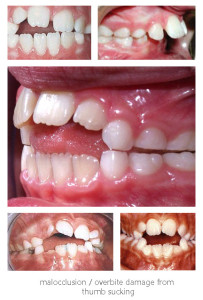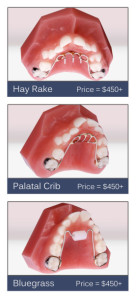This can be a much more serious problem than it may seem. This is because thumb sucking beyond the age of 1 – 2 years can be detrimental to a child’s teeth as well as their swallow and speech.

Isn’t it normal for babies to suck their thumb?
Yes! Sucking is a baby’s first instinct. It is healthy and normal for babies to suck their thumb and fingers and is usually linked to their need for food and exploration.
 Thumb sucking can vary greatly between individual babies. Some babies suck their thumb often while other babies show little interest in doing so. The need for sucking tends to decrease around six months of age when they start eating solids and usually lessens or completely stops around 12 months of age. Thumb sucking is normally little cause for concern regarding dental development up to the age of 12 months. However, after the age of two, thumb sucking can be a problem.
Thumb sucking can vary greatly between individual babies. Some babies suck their thumb often while other babies show little interest in doing so. The need for sucking tends to decrease around six months of age when they start eating solids and usually lessens or completely stops around 12 months of age. Thumb sucking is normally little cause for concern regarding dental development up to the age of 12 months. However, after the age of two, thumb sucking can be a problem.
How does thumb sucking affect a child’s teeth?

Thumb sucking can result in “malocclusions” which means that the upper and lower teeth come together incorrectly. The most common type of malocclusion that kids can have due to prolonged thumb sucking, is when the upper teeth are pushed forward, as though they are moving toward sticking straight out. This is called an “overjet”, which is slightly different from the more commonly heard term “overbite”.
Chewing food properly may be difficult for some kids because their teeth aren’t lined up properly for them to chew effectively. The other problem often seen in kids who have their teeth pushed forward as a result of thumb sucking, is that there can be some facial distortion as the forward position of the teeth and jaw affect the overall shape of the face.
How does thumb sucking affect a child’s speech and swallowing?
Due to the constant forward and backward movement of the tongue as they’re sucking, a child is likely to have a tongue thrust swallow pattern. This can affect their ability to swallow properly, their dentition and their speech sounds. See our tongue thrust swallow page for more information.
Speech disorders are also a common problem as a result of thumb sucking. An interdental lisp is usually the most common problem that we see, which is the tongue pushing out between the front teeth when producing the /s/ or /z/ sounds. The habit of the continuous forward motion of the tongue however, not just affects the /s/ and /z/ sounds, but can also affect other sounds that we produce with our tongue such as /t/, /d/, /n/, /l/, /sh/, /ch/ and /j/.
As you can see, that’s quite a few sounds that can be affected in a child’s speech as a result of prolonged thumb sucking. This is why early intervention is the key! Not just in doing speech therapy to correct a child’s speech errors or their tongue thrust swallow, but tackling the underlying problem – breaking the thumb sucking habit.
Tips for breaking the thumb sucking habit
- It is crucial to try and prevent a child from forming a habit of thumb sucking beyond the age of two years, and especially before their permanent teeth come through around the age of five to six years. Prevention is better than cure. So when you notice your baby sucking their thumb on a regular basis, gently pull out the thumb when you see it. By not letting it become a habit in the first place, it will save you a lot of time, money and frustration down the track when it can be much harder to break.
- Simply telling your toddler/child to stop sucking their thumb, or asking them to take it out, just doesn’t work for most. Instead, try rewarding and praising your child every time they are NOT sucking their thumb rather than focusing on the times that they are. Concentrate on the expected behaviour (not sucking the thumb) by using lots of praise such as “wow, I like how you’re not sucking your thumb” or “I like how your hands are sitting nicely on your lap” (good to use when they’re watching TV for example). Give them something to play with using their hands to keep them occupied such as Playdoh, drawing or building a tower with blocks. Make sure you praise every time they are not sucking their thumb to encourage this behaviour. Reward charts such as sticker charts are also a great tool use as an extra incentive.
- In addition to using positive reinforcement to break the habit for thumb sucking, using a fabric or plastic thumb cover may help. This is because it will make it difficult to get the thumb into the mouth and/or it simply

Thumb guards doesn’t feel the same. These thumb covers are particularly good to use at night time as the child is unaware they are doing it. Some children however, find a way to get these covers off in their sleep and the thumb finds its way back into their mouth. You may need to come up with an inventive way of keeping it on your child’s thumb.
- One of the more commonly known thumb sucking habit breakers is the use of special nail polish. This discourages putting the thumb in the mouth due to its terrible taste. This might be a better solution for children during the day than some thumb covers as it still allows the child to have full use of their hands. A potential drawback of this option is that some children do not seem to be bothered by the taste and/or the urge to suck their thumbs is stronger. It is highly recommended to use this option in conjunction with the positive reinforcement strategy to break the thumb sucking habit.
-

Dental devices to break thumb sucking habit What do you do if you have exhausted all your options to break the thumb sucking habit and your child has still not kicked the habit? See your dentist/orthodontist about getting a dental device fitted. These go by various names, depending on design, but research has shown them to be very effective in stopping this habit. The downside of these devices are that there is a notable expense, not to mention some of the pain and discomfort the child may experience during the fitting stage (similar to getting braces fitted). Children will have to wear these devices 24 hours a day for a few weeks, however, it will stop the thumb sucking habit.
Stopping thumb sucking EARLY (or even better, preventing it) means that none of this has to happen and the child’s teeth will not be misaligned and their speech, language and swallow can develop correctly. It will save you thousands of dollars in dental appointments, speech therapy sessions and the overall time and hassle of trying to fix a problem that could have been prevented if thumb sucking did not become habit.
If your child is having difficulties with their speech and/or swallowing development as a result of previous or current thumb sucking, it is highly recommended to see a speech pathologist. They will be able to assess how their speech is developing and look at their swallow pattern to determine the nature and severity of the difficulties. A speech pathologist can also help to correct lisps and other speech errors as well as correct tongue thrust swallowing.
Have you got any additional tips on how to break the thumb sucking habit? Leave a comment below if you’ve found a good solution and let us know how your child’s thumb sucking journey went.

BA, MSpPathSt, CPSP, MSPA
Speech Language Pathologist
Monique Speakman is a Paediatric Speech Pathologist in Brisbane with over 10 years experience, mother of a son and twin daughters, business owner and blogger. She aims to educate parents about child development and communication through the Kids Chatter Speech Pathology Blog and Facebook Page and to provide information and tips on anything to do with Speech Pathology.

